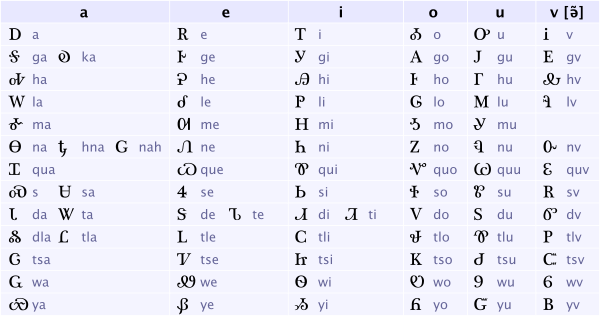Cherokee syllabary
| Cherokee |
|
|---|---|
| Type | |
| Languages | Cherokee language |
|
Time period
|
1820s–present |
|
Parent systems
|
inspired by the Latin script
|
| Direction | Left-to-right |
| ISO 15924 | Cher, 445 |
|
Unicode alias
|
Cherokee |
|
|
 |
|
|
|
The Cherokee syllabary is a syllabary invented by Sequoyah to write the Cherokee language in the late 1810s and early 1820s. His creation of the syllabary is particularly noteworthy in that he could not previously read any script. He first experimented with logograms, but his system later developed into a syllabary. In his system, each symbol represents a syllable rather than a single phoneme; the 85 (originally 86) characters provide a suitable method to write Cherokee. Although some symbols resemble Latin, Greek and Cyrillic letters, the relationship between symbols and sounds is different.
Each of the characters represents one syllable, as in the Japanese kana and the Bronze Age Greek Linear B writing systems. The first six characters represent isolated vowel syllables. Characters for combined consonant and vowel syllables then follow.
The charts below show the syllabary in recitation order, left to right, top to bottom as arranged by Samuel Worcester, along with his commonly used transliterations. He played a key role in the development of Cherokee printing from 1828 until his death in 1859.
In the image, the Latin letter ‘v’ in the transcriptions, in the last column, represents a nasal vowel, /ə̃/.
...
Wikipedia

